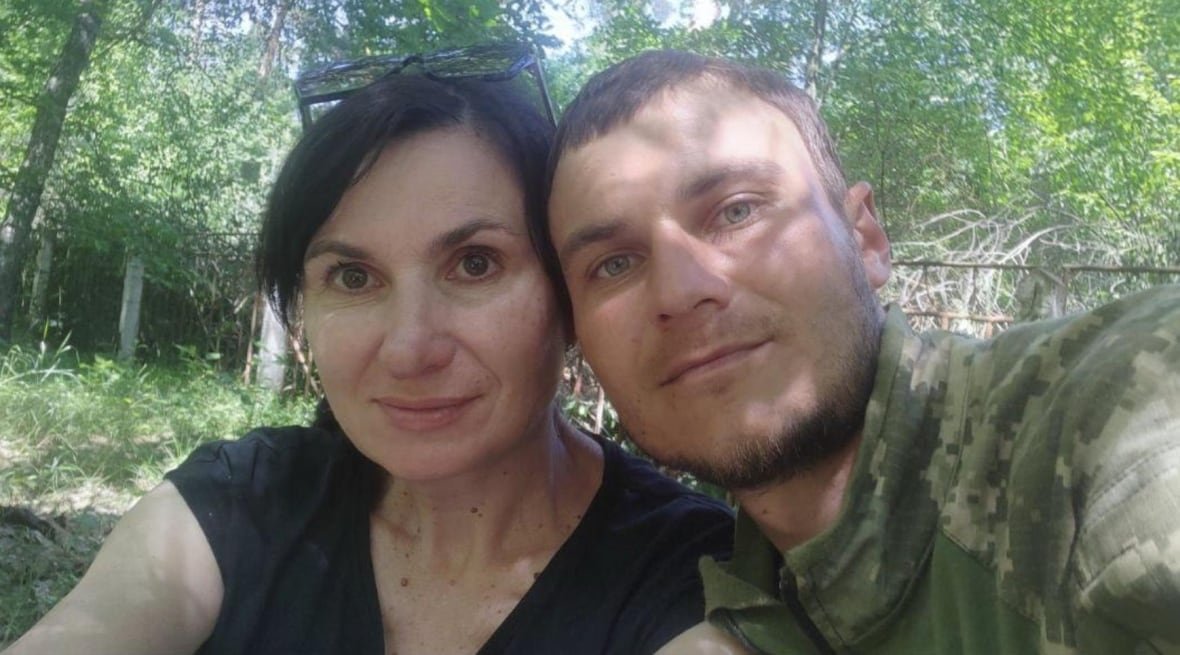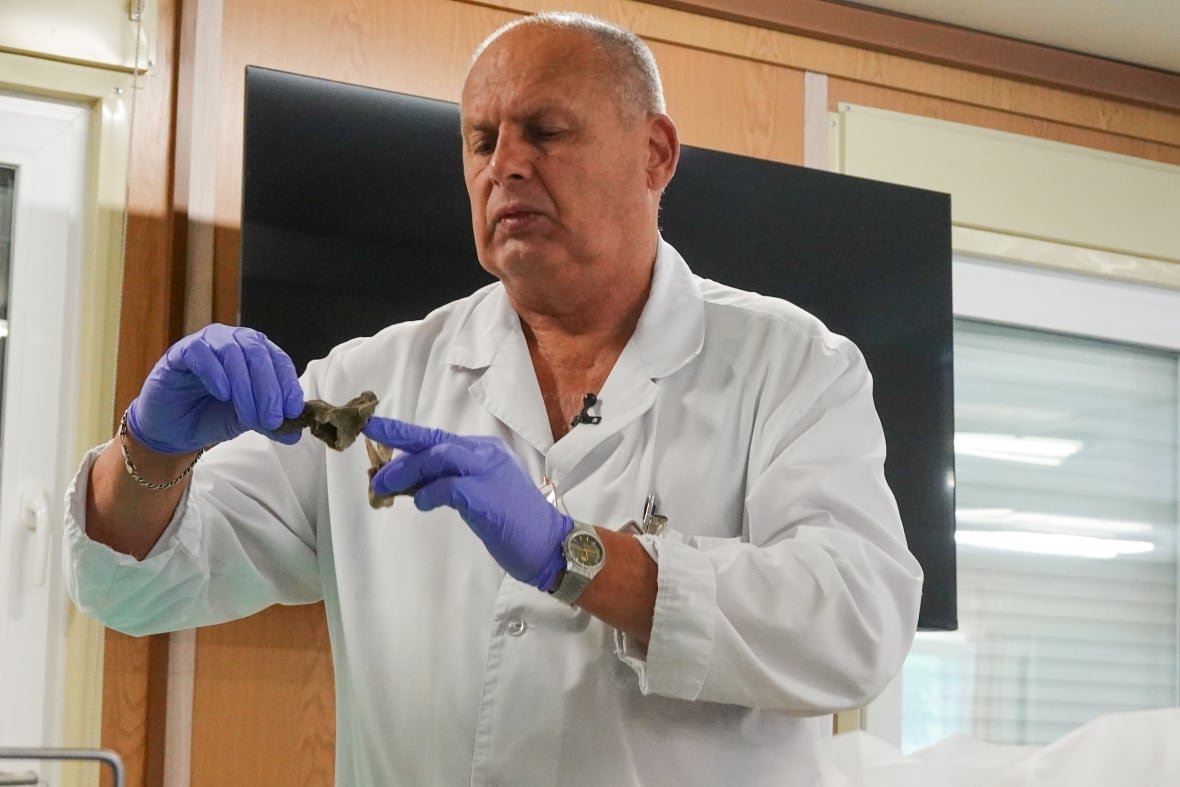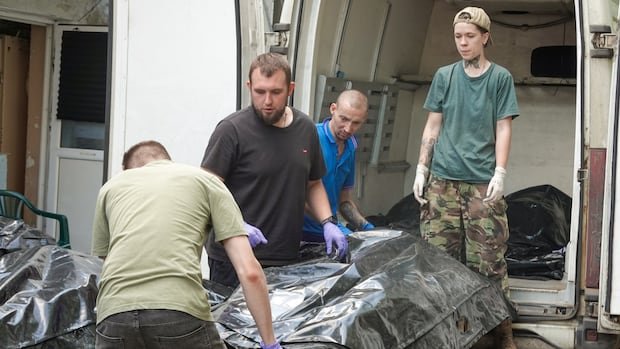In a small reception room at a hospital in Dnipro, in south-central Ukraine, Viktoria Lants struggled to look at the computer screen as a forensic worker shuffled through photos of the remains catalogued in the overwhelmed morgue.
Some images were of badly damaged bodies, military clothing and a pocket knife.
When her family was led into a refrigerated unit to view one body, her eyes lingered on a wooden cross.
Lants’s 31-year-old son, Vladyslav Kharkov, was given a similar one by his grandmother before he was sent to the front line over the summer.
The last time she spoke to him was on Aug. 19.
“He said everything will be fine, Mom. He knew how everyone was worried about him,” she said, recalling their final phone conversation.
Kharkov, who previously worked as a contractor before being drafted in the spring by Ukraine in its ongoing war with Russia, is officially listed as missing — one of tens of thousands of soldiers on a national missing persons registry.
Crowded morgues and growing cemeteries
Across the country, morgues are overburdened and forensic investigators are working around the clock to identify the growing number of dead — and in some cases release them for burial even before their identities are confirmed.
In the more than three and a half years since Russia launched its full-scale invasion of Ukraine, there has been very little information released by Kyiv or Moscow about the number of soldiers killed.
Independent Russian media have compiled a list showing that at least 130,000 Russian soldiers have been killed, but they estimate that the true number is nearly double that.
Thousands of remains are transported back to Ukraine from the battlefields, and forensic investigators are overwhelmed trying to identify the growing number of dead. CBC’s Briar Stewart explains how they do it.
In December 2024, Ukrainian President Volodymyr Zelenskyy stated that 43,000 Ukrainian soldiers had been killed. He disclosed that number on social media after Donald Trump, who was the U.S. president-elect at the time, claimed that Ukraine had “ridiculously lost” 400,000 soldiers.
While Trump’s efforts to broker a ceasefire between the two sides have floundered, one of the few agreements to come out of the limited negotiations included the mass repatriation of the dead.
In June, the remains of 6,057 soldiers were transported back to Ukraine, according to officials, while the Kremlin said it received 78 bodies. Neither side commented on why the numbers exchange appeared lopsided.

A few weeks before the bodies from the mass repatriation were transported to morgues across Ukraine, Vladyslav Kharkov was sent to military training. The father of a nine-year-old girl, he was conscripted by officers while standing at a train station in the Vinnytsia region, in west-central Ukraine, and put on a bus.
Lants, his mother, compares his mobilization to a “kidnapping” and demands to know how many members of Ukraine’s political elite have sent their sons out of the country to avoid serving.
“Everyone should be equal in the face of war,” she said. “How many mothers are there like me?”
The wait for an answer
At the morgue, Lants and her daughter-in-law were led into a refrigerated unit to try to identify her son. She returned clearly shaken. While she said the body was not in good condition, she believes it was her son because of a mole that was visible on his stomach.
She and her husband provided DNA samples, but it could be months before the lab tests are returned.
Until then, she is dreading a phone call and an answer she doesn’t want to hear. “I hope that is a mistake … that it’s not true. It’s just a terrible dream,” Lants said.

Her mind keeps returning to the day after her son was born. She said a maternity nurse brought a baby to her bedside to feed, but right away she knew it wasn’t hers.
While the tag on the blanket bore his name, upon closer look, a different one was written on the hospital bracelet that the babies were given moments after birth.
After the mix-up, her son was returned to her, and she holds onto the possibility — however small — that something similar might have happened this time.
The International Committee of the Red Cross (ICRC) is aiding forensic investigators in Ukraine, giving advice and helping to increase the capacity of a system that wasn’t designed to handle the grim toll of a grinding war.
“They have great expertise within the country, and they know what they are doing. It is very clear that they are, however, overwhelmed,” said Tania Bertrand, an ICRC forensic specialist from Montreal who has been based in Dnipro for the past year.
Crosses mark unidentified soldiers’ graves
Inside a forensic lab in Dnipro, Valerii Viun pulled bone fragments out of a box that came from the front line in Ukraine’s Donetsk region.
The head of the forensic medical criminology department laid them on the table. His aim is to figure out if they are all human and how many people they might have belonged to.
Viun said that when the remains include soft tissue, the lab will do a DNA test. But because of the violent nature of war, sometimes investigators have only bone fragments to work with.

“Everyone has the right to a decent life, and everyone has the right to a dignified death,” Viun said. “We don’t want to allow a person to be buried without a name.”
But at a sprawling cemetery in Dnipro, there is a growing section dedicated to unidentified soldiers. Plaques affixed to simple wooden crosses describe the person as “temporarily unidentified.”
The bodies are buried in large part because of a lack of space in cold storage units.
‘These kids will never see their dad again’
Outside of the forensic lab where Viun works, there is the constant hum of refrigeration trucks.
Viun said he is now living at the hospital because there is so much work to do, and it is getting harder to reach his community further east in the Dnipro region, where Russian forces are trying to push further in and control even more Ukrainian territory.
At night sometimes, when the window is open, he said he hears the trucks, along with the screams and cries of women who have just identified a loved one.
“The hardest part is when you do not have time to hug a mother who has just recognized her son,” Viun said. “The scariest thing is when I see kids running around here … and these kids will never see their dad again.”
Sometimes, he said, despite all of the tests done to confirm a person’s identity, a family just doesn’t want to accept that their loved one is dead, choosing instead to believe that they must be a prisoner of war in captivity.
Viun, who has been working in forensics for 45 years, said he believes he will spend the rest of his life trying to identify Ukraine’s dead from this war.
When the war eventually ends, he said, there will be surge of even more recovered remains from areas that have been largely inaccessible along the front.
“There will be a lot of bodies that have not yet been found and these bodies need to be identified,” he said. “The work will still be hell for another 10 years.”


